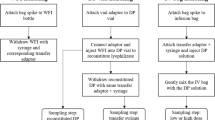Abstract
Purpose
As per the Japanese or SUPAC guidance to maintain formulation composition similarity across tablet strengths, the coating should be applied based on the core tablet surface area or weight, respectively. These two coating approaches were compared by evaluating protective effects of coating on the light stability of three model compounds.
Methods
Core tablets of three light sensitive drugs, nifedipine, rosuvastatin calcium, and montelukast sodium were coated either with PVA-based Opadry® II white or Opadry® II beige. The coated tablets were exposed to light up to three ICH cycles.
Results
For Opadry® II white, the surface area based coating provided consistent light protection across tablet strengths when the coating amount was more than 0.1 mg/mm2 compared to that based on core tablet weights. For Opadry® II beige, both approaches gave comparable and better light protection due to presence of iron oxides. The light protection by Opadry® II white could be because of physical barrier of coating, which was uniform across the strengths when it was based on core tablet surface area.
Conclusion
For a routine tablet formulation development with Opadry color coating, it does not matter whether the coating is applied based on the core tablet surface area or weight.




Similar content being viewed by others
References
US FDA. Bioavailability studies submitted in NDAs or INDs – general considerations 2019 [Available from: https://www.fda.gov/regulatory-information/search-fda-guidance-documents/bioavailability-studies-submitted-ndas-or-inds-general-considerations.
CDER. Waiver of in vivo bioavailability and bioequivalence studies for immediate-release solid oral dosage forms based on a biopharmaceutics classification system guidance for industry 2017 [Available from: https://www.fda.gov/media/70963/download.
Agency EM. ICH Topic Q 1 D bracketing and matrixing designs for stability testing of drug substances and drug products 2002 [Available from: https://www.ema.europa.eu/en/documents/scientific-guideline/ich-q-1-d-bracketing-matrixing-designs-stability-testing-drug-substances-drug-products-step-5_en.pdf.
Pharmaceutical and food safety bureau . “Guideline for bioequivalence studies for formulation changes of oral solid dosage forms” English translation of Attachment 3 of Division-Notification 0229 No. 10 of the Pharmaceutical and Food Safety Bureau. Dated 2012; February 29. 2012 [Available from: https://www.nihs.go.jp/drug/be-guide(e)/form/GL-E_120229_shohou.pdf.
USFDA. SUPAC-IR: Immediate-release solid oral dosage forms: scale-up and post-approval changes: Chemistry, manufacturing and controls, in vitro dissolution testing, and in vivo bioequivalence documentation. 1995.
Maafi M, Maafi W. Montelukast photodegradation: elucidation of Ф-order kinetics, determination of quantum yields and application to actinometry. Int J Pharm. 2014;471(1–2):544–52.
Maafi W, Maafi M. Modelling nifedipine photodegradation, photostability and actinometric properties. Int J Pharm. 2013;456(1):153–64.
Matsuda Y, Teraoka R, Sugimoto I. Comparative evaluation of photostability of solid-state nifedipine under ordinary and intensive light irradiation conditions. Int J Pharm. 1989;54(3):211–21.
Shah RP, Sahu A Fau - Singh S, Singh S. LC-MS/TOF, LC-MSn, on-line H/D exchange and LC-NMR studies on rosuvastatin degradation and in silico determination of toxicity of its degradation products: a comprehensive approach during drug development. (1618–2650 (Electronic)).
CDER and CBER. Guidance for industry Q1B photostability testing of new drug substances and products 1996 [Available from: https://www.fda.gov/media/71713/download.
Desai DS, Abdelnasser MA, Rubitski BA, Varia SA. Photostabilization of uncoated tablets of sorivudine and nifedipine by incorporation of synthetic iron oxides. Int J Pharm. 1994;103(1):69–76.
Chen W, Chang SY, Kiang S, Marchut A, Lyngberg O, Wang J, et al. Modeling of pan coating processes: prediction of tablet content uniformity and determination of critical process parameters. J Pharm Sci. 2010;99(7):3213–25.
Teraoka R, Matsuda Y, Sugimoto I. Quantitative design for photostabilization of nifedipine by using titanium dioxide and/or tartrazine as colourants in model film coating systems. J Pharm Pharmacol. 1989;41(5):293–7.
El Hagrasy A, Chang SY, Desai D, Kiang S. Application of Raman spectroscopy for quantitative in-line monitoring of tablet coating. American Pharmaceutical Review. 2006;9:40–5.
El Hagrasy AS, Chang S-Y, Desai D, Kiang S. Raman spectroscopy for the determination of coating uniformity of tablets: assessment of product quality and coating pan mixing efficiency during scale-up. J Pharm Innov. 2006;1(1):37–42.
Author information
Authors and Affiliations
Corresponding author
Additional information
Publisher’s Note
Springer Nature remains neutral with regard to jurisdictional claims in published maps and institutional affiliations.
Rights and permissions
About this article
Cite this article
Reddy, J.P., Vyas, G., Patel, R. et al. To Maintain Formulation Composition Similarity of Coated Tablets of Different Strengths: Should Coating be Based on Core Tablet Weight or Surface Area?. Pharm Res 37, 201 (2020). https://doi.org/10.1007/s11095-020-02926-5
Received:
Accepted:
Published:
DOI: https://doi.org/10.1007/s11095-020-02926-5




